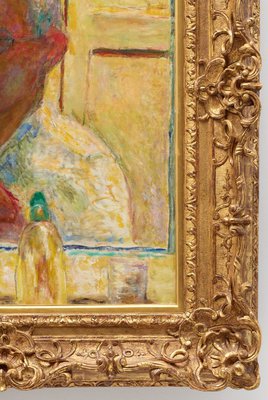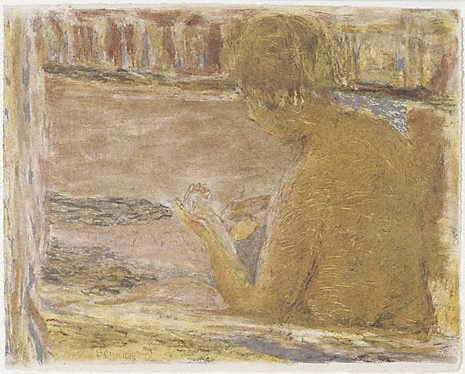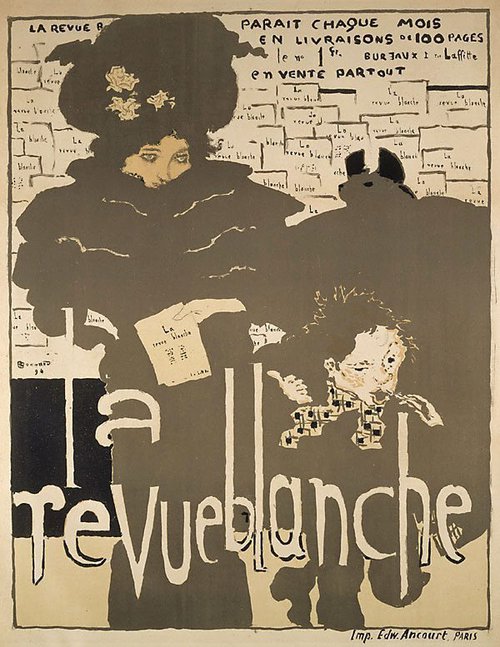-
Details
- Other Title
- Self portrait in dressing room mirror
- Alternative title
- Portrait du peintre par lui-même
- Date
- circa 1938-circa 1940
- Media category
- Painting
- Materials used
- oil on canvas
- Dimensions
- 76.2 x 61.0 cm stretcher; 105.0 x 89.0 x 10.5 cm frame
- Signature & date
Signed u.r., brown oil "Bonnard". Not dated.
- Credit
- Purchased 1972
- Location
- South Building, ground level, 20th-century galleries
- Accession number
- 6.1972
- Copyright
- Artist information
-
Pierre Bonnard
Works in the collection
- Share
-
-
About
A founder member of the French Nabi movement and a radiant colourist, Pierre Bonnard painted almost a dozen self-portraits, most of them in later life. He very rarely dated these works, the first of which he painted while he was an art student of twenty-two, in 1889 (Private Collection). In the 1930s he developed an interest in depicting himself in front of a mirror; the last in this series is thought to have been completed in 1945, two years before his death.1
A self-portrait often implies an artist's direct engagement with a mirror, but unlike the Impressionists, Bonnard did not paint directly from the motif, preferring instead to make drawings, sketches and colour notes and then working up his paintings in the studio. He believed that painters capable of tackling the motif directly were very rare, declaring, 'It is not a matter of painting life. It's a matter of giving life to painting'.2 Like Matisse, he used colour and decoration determined the essential qualities of his art. Bonnard admired not only Japanese prints and screens but also Persian and Indian miniatures, capturing something of their iridescent multiplicity in this self-portrait with its brilliant orchestration of near and far views and its vibrant notes of Indian yellow, ultramarine, emerald green, creamy white and deep, reddish purple. With his eyes half closed behind Ghandi-style glasses, Bonnard cups his hands in a curious gesture, recalling his 1931 self-portrait known as 'The boxer' (Private Collection). But in this later self-portrait his raised hands conceal the initial occasion of his painting - a fleeting glimpse of his mirrored reflection quickly jotted down in a spontaneous drawing small enough to fit in the palm of one hand. It was that invisible little notebook drawing which blossomed over time into a poignant, almost painfully vulnerable self-portrait that fused pigment, flesh and atmosphere.
Fascinated by the possibilities of mirror reflections, Bonnard exploits them for their tantalizingly oblique glimpses into his private realm. In this self-portrait his pulpy, dark-skinned flesh, severed by the mirror's edge and transfixed by a harsh electric light, is squeezed into the narrow space behind the mirror's reflective surface. Our gaze is thence deflected by myriad smaller reflections and by the eyeglasses that mask his modest gaze.
Completed during the increasingly austere and dangerous years of the German Occupation in France, when Bonnard was living in Le Cannet near Cannes, this self-portrait echoes his growing sense of personal fragility and impending mortality. In 1930 the Surrealist poet Louis Aragon predicted: 'painting will become an anodyne amusement for young girls and old provincials'.3 In a post-Cubist climate some avant-garde critics dismissed Bonnard as old-fashioned and irrelevant. Their attacks had disturbed him and may have prompted the series of probing late self-portraits. In deep concentration, with an undiminished desire to understand and fulfil himself as an artist, Bonnard's self-portraits defied the climate of the times: 'I am working a lot, immersed more and more deeply in this outdated passion for painting. Perhaps with a few others, I am one of its last survivors'.4
Ursula Prunster
1. Terrasse called this 'an internal examination of self' which showed an artist who 'lived at a remove from the world, sacrificing all to the passion for art' see Antoine Terrasse, 'Bonnard: The Colour of Daily Life', trans. Laurel Hirsch, Thames and Hudson, London 2000, p.108.
2. Angèle Lamotte, 'Le Bouquet de Roses – Propos de Pierre Bonnard recueillis en 1943', 'Verve 5', nos 17-18 (August 1947) n.p. Bonnard continues: '… those [painters] who were able to extricate themselves from it [the motif] had a very personal defence. Faced with the motif, Cézanne had a solid idea of what he wanted to do - taking from nature only what was relevant to his idea.' See also Bonnard 1946, in Antoine Terrasse, 'Les Notes de Bonnard' in 'Bonnard', Centre Georges Pompidou, Paris 1984, p.202
3. Louis Aragon, 'La Peinture au défie' quoted in Antoine Terrasse, 2000, p.96
4. Bonnard letter to his nephew, Charles Terrasse, 1933, quoted in Antoine Terrasse, 2000, pp.96-7
-
Exhibition history
Shown in 17 exhibitions
Accessions and proposals, The Museum of Fine Arts, Houston, United States of America, 30 Apr 1964–24 May 1964
Bonnard and his environment, The Museum of Modern Art, United States of America, 07 Oct 1964–29 Nov 1964
Bonnard and his environment, The Art Institute of Chicago, United States of America, 08 Jan 1965–28 Feb 1965
Bonnard and his environment, Los Angeles County Museum of Art, Los Angeles, 31 Mar 1965–30 May 1965
Pierre Bonnard, Royal Academy of Arts, London, 06 Jan 1966–06 Mar 1966
Pierre Bonnard, National Gallery of Victoria [St Kilda Road], Melbourne, May 1971–mid Jun 1971
Pierre Bonnard, Art Gallery of South Australia, Adelaide, 24 Jun 1971–25 Jul 1971
Pierre Bonnard, Art Gallery of Western Australia, Perth, 06 Aug 1971–12 Sep 1971
Pierre Bonnard, Australian Museum, Sydney, 15 Oct 1971–10 Nov 1971
Bonnard, Kunsthaus Zürich, Zurich, 14 Dec 1984–10 Mar 1985
Bonnard, Städtische Galerie im Städelschen Kunstinstitut, Frankfurt am Main, 03 May 1985–14 Jul 1985
The last gaze. Late self-portraits (from Bonnard to Bacon), Museu D'Art Contemporani, Barcelona, Barcelona, 16 Oct 1997–06 Jan 1998
Bonnard, Tate Britain, England, 12 Feb 1998–17 May 1998
Bonnard, The Museum of Modern Art, United States of America, 17 Jun 1998–13 Oct 1998
Pierre Bonnard: early and late, The Phillips Collection, United States of America, 22 Sep 2002–19 Jan 2003
Pierre Bonnard: early and late, Denver Art Museum, United States of America, 01 Mar 2003–25 May 2003
Pierre Bonnard: observing nature, Queensland Art Gallery, South Brisbane, 04 Jul 2003–28 Sep 2003
Self portrait: Renaissance to contemporary, National Portrait Gallery, London, England, 20 Oct 2005–29 Jan 2006
Self portrait: Renaissance to contemporary, Art Gallery of New South Wales, Sydney, 17 Feb 2006–14 May 2006
Bonnard, Matisse and the Mediterranean, Complesso Monumentale del Vittoriano, Rome, 06 Oct 2006–04 Feb 2007
Pierre Bonnard: the late interiors, The Metropolitan Museum of Art, New York, 26 Jan 2009–19 Apr 2009
From Van Gogh to FaceTime. Self Portraits in the 20th and 21st Centuries, Louisiana Museum of Modern Art, Denmark, 14 Sep 2012–13 Jan 2013
Modernists: selections from the European collection, Art Gallery of New South Wales, Sydney, 07 Nov 2015–25 Apr 2016
Archie Plus, Art Gallery of New South Wales, Sydney, 26 Sep 2020–07 Mar 2021
20th-Century galleries, ground level (rehang), Art Gallery of New South Wales, Sydney, 20 Aug 2022–2023
Pierre Bonnard, National Gallery of Victoria [St Kilda Road], Melbourne, 09 Jun 2023–08 Oct 2023
-
Bibliography
Referenced in 37 publications
-
Art Gallery of New South Wales, Art Gallery of New South Wales picturebook, Sydney, 1972, cover (colour illus.).
-
Tony Bond and Wayne Tunnicliffe, Contemporary: Art Gallery of New South Wales Contemporary Collection, 'Collecting contemporary art at AGNSW', pg.424-441, Sydney, 2006, 425.
-
Edmund Capon AM, OBE and Jan Meek (Editors), Portrait of a Gallery, 'European 20th Century Art', pg. 91-95, Sydney, 1984, 93 (colour illus.).
-
Edmund Capon, Look, 'And then there were two', pg.24-25, Melbourne, Jul 2001, 24 (colour illus.).
-
Betty Churcher, Australian notebooks, 'ART GALLERY OF NEW SOUTH WALES', pg. 45-90, Melbourne, 2014, 62 (colour illus.), 63-65, 252.
-
Complesso Monumentale del Vittoriano, Matisse e Bonnard, Viva la pittura!, Rome, 2006, 476, 477 (colour illus.). cat.no.218
-
Laura Cumming, A face to the world: on self-portraits, 'Mirrors', London, 2009, 149 (colour illus.).
-
Jean Dauberville and Henry Dauberville, Bonnard catalogue raisonné de l'oeuvre peint, '1940-1947', Paris, 1966-1974, Vol. 4, 37 (illus.). cat.no. 1599, 'Portrait du peintre par lui-même'
-
James Elliott and Monroe Wheeler (Curators), Bonnard and his environment, New York, 1964, 98 (colour illus.). cat.no. 74
-
Jack Flam, Pierre Bonnard: the late still lifes and interiors, 'Bonnard in the history of twentieth-century art', pg.47-59, New Haven, 2009, 47, 167 (colour illus.), 169. cat.no.74
-
Foundation Wildenstein, Pierre Bonnard, London, 1971, cover (colour illus.). cat.no. 36
-
Renée Free, Art Gallery of New South Wales Collection Series: European 1: Pierre Bonnard, Self-portrait in dressing-room mirror, Sydney, 1981, cover, (colour illus.).
-
Renée Free, Art Gallery of New South Wales handbook, 'European', pg. 36-56, Sydney, 1988, 51 (colour illus.).
-
Renee Free, Art and Australia, 'European Collection', p.63-75, Sydney, Jul 1972, 74 (illus.).
-
Renee Free, Art Gallery of New South Wales Annual, 'Pierre Bonnard: Self-portrait at 73', p6-9, Sydney, 1974-1975, 7 (illus.). fig.no. 1
-
Sasha Grishin, The Canberra times, 'Reflecting the artist's self', pg.8-9, Canberra, 26 Feb 2006, Relax: 8 (colour illus.). Sunday supplement
-
Nicholas Harding, Look, 'The art that made me', Sydney, Aug 2022-Sep 2022, pp 19–21: p 20, col illus p 20.
-
Bruce James, Art Gallery of New South Wales handbook, 'Western Collection: Paintings and Sculpture', pg. 17-77, Sydney, 1999, 61 (colour illus.).
-
Kunsthaus Zürich, Pierre Bonnard, Zurich, 1984, 276, 277 (colour illus.). cat.no. 145
-
Peter Laverty, Art and Australia (Vol. 20, No. 2), 'Artist's Choice No.12 Pierre Bonnard: Self-portrait', pg. 246-247, Sydney, Summer 1982, 246, 247 (colour illus.).
-
Clem Lloyd and Peter Sekuless, Australia's national collections, Sydney, 1980, 256 (illus.).
-
Ewen McDonald, AGNSW Collections, The Western Heritage, Renaissance to 20th Century, Sydney, 1994, 163 (colour illus.).
-
Chiara O'Reilly, Journal of the history of collections, vol 32, no 2, 'Collecting French art in the late 1800s at the Art Gallery of New South Wales', Jul 2020, pp 313–35: p 323.
-
Justin Paton, Look, 'Against the light', pg.52-8, Sydney, May 2018-Jun 2018, 52, 53 (colour illus.), 55, 57-8.
-
Liz Rideal, Self-portrait, 'Golden years? 1905-1950: a non digital world. Self-expression, self-promotion, self-preservation', pg.21-25, Humlebæk, 2012, 24, 63 (colour illus.). cat.no.10
-
Ross Steele, Art and Australia, 'French Impressions', pg. 87-93, Sydney, Spring 1984, 92 (colour illus.), 93.
-
Denys Sutton, Pierre Bonnard, London, 1966. cat.no. 246
-
Antoine Terrasse, Bonnard, Paris, 1988, (colour illus.). cat.no. 295
-
Charles Terrasse, Apollo, 'Recollections of Bonnard', London, Jan 1966, 63 (illus.).
-
Michel Terrasse, Bonnard at Le Cannet, 'The Self Portraits', pg. 115-119, London, 1988, 116 (illus.). as Autoportrait, Private Collection USA
-
Angus Trumble, The Burlington Magazine, 'Bonnard', pg. 749-750, London, Oct 2003, 749, 750 (colour illus.). exhibition review
-
Elizabeth Hutton Turner, Pierre Bonnard: early and late, 'The imaginary cinema of Pierre Bonnard', pg.52-73, London, 2002, 72 (colour illus.), 234 (colour illus.). fig. 87, plate 135
-
Annette Vaillant, Bonnard, London, 1966, 137 (colour illus.). Originally published in french as Bonnard; ou, Le bonheur de voir. Neuchatel, Ides et Calendes, 1965.
-
Sarah Whitfield, Bonnard, London, 1998, 208, 209 (colour illus.), 269. cat.no. 78
-
Joanna Woodall, Self portrait: Renaissance to contemporary, '"Every painter paints himself": self-portraiture and creativity', pg.18-29, London, 2005, 27, 37, 174 (colour illus.), 175, 200. cat.no. 45
-
Jörg Zutter, Pierre Bonnard: observing nature, 'Pierre Bonnard: Observing Nature', pg.37-73, Canberra, 2003, 67 (colour illus.), 68. fig.66, cat.55
-
Editor Unknown, Le Figaro magazine, Paris, 14 Jan 2006, (colour illus.).
-
-
Provenance
Pierre Bonnard, circa 1938-1947, France
Bonnard Estate, 1947-1963, France, By descent to his heirs, the Terrasse family 1963; to Wildenstein & Co., 1963
Wildenstein & Co., 1963-1972, New York/New York/United States of America, Purchased by the AGNSW from Wildenstein & Co. 1972.





